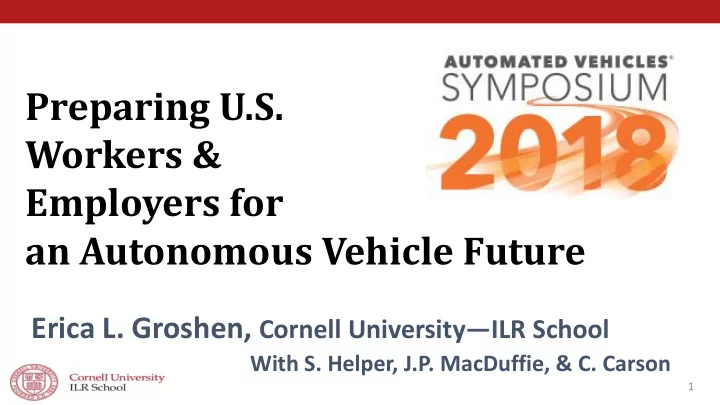

Preparing U.S. Workers & Employers for an Autonomous Vehicle Future Erica L. Groshen, Cornell University — ILR School With S. Helper, J.P. MacDuffie, & C. Carson 1
Agenda • Lessons from past innovations • Sizing and timing AV’s impact on workers • Next steps 2
Innovation is not new • Industrial Revolution in England, 1750-1900 • Autopilot in aviation, 1912-now • Computer numerical control in machine tools, 1960-1990 • Automation in auto assembly plants, 1980s-now • Automatic teller machines, 1980s-now • Trade expansion with China, 1990-now • Self-driving trucks in Australian strip mines, 2000-now 3
Lessons from past transitions • Full employment returns • Costs to workers • Concentrated & high • Uncertain • Precede benefits • Fuel unrest & resistance • Benefits accrue diffusely & unevenly • Policy & implementation matter 4
AV adoption Lost jobs Higher productivity Displaced workers Lower transportation prices move without cost to new jobs We buy more We buy more other things transportation New AV-supporting Non-AV Transportation inputs suppliers companies companies for AV New jobs New jobs New jobs
AV adoption Lost jobs & income Higher productivity Gaps hinder Lower transportation prices effective adjustment: • Geography We buy more We buy more • Skills other things transportation • Worker voice New AV-supporting Non-AV Transportation • Investment inputs suppliers companies companies for AV New jobs New jobs New jobs
Reducing adjustment gaps • Key to success • Historically neglected 7
Sizing and timing AV’s impacts 8
1.3 – 2.3 million workers displaced Total Number of Workers Displaced by AV Adoption Scenario, 2018 - 2051, in Thousands 2,500 Combined scenarios Individual scenarios 2,000 1,500 1,000 500 - Trucking-Fast Trucking-Slow Cars-Fleet Cars-Personal Trucking-Fast + Trucking-Fast + Trucking-Slow Trucking-Slow Cars-Fleet Cars-Personal + Cars-Fleet + Cars-Personal 9
Unemployment: max +0.13 percentage pt in mid-2040s Marginal Contribution of AV Displacements to Unemployment Rate 0.14 Percentage point difference in 0.12 unemployment rate 0.10 0.08 0.06 0.04 0.02 0.00 2017 2018 2019 2020 2021 2022 2023 2024 2025 2026 2027 2028 2029 2030 2031 2032 2033 2034 2035 2036 2037 2038 2039 2040 2041 2042 2043 2044 2045 2046 2047 2048 2049 2050 Projection Range AV Unemployment - Low AV Unemployment - High 10
Impact consequential & manageable • Workers displaced (2018-2051): 1.3-2.3 M • +0.13 percentage pt to unemployment at peak • -0.1 percentage pt to participation at peak • ½ size of China shock • Wealth losses: $200-$300 B • $80-$120K/worker • Worse in recessions • Timing: max in mid-2040s • Starts slowly 11
Next steps 12
Choose a path Mitigation Strategy Paths Passive Reactionary Investment Deploy AV rapidly & Slow down AV adoption to Deploy AV rapidly & accept high costs to allow current workforce direct some benefits to workers at risk of social system to handle transition invest in comprehensive disruption and resistance without high costs cost mitigation 13
What would comprehensive cost mitigation look like? Strengthen existing system -- UI, Workforce Innovation & Opportunity Act, CCs Employers engaged Adequately funded for inclusive eligibility -- not only AV Multi-pronged Evidence-based • Worker voice • Program experiments & evaluations • Training • Relevant, high-quality official statistics • Place-based • Administrative data • Income support • Research • Search & placement • Stakeholder input 14
Some of many tested policy tools • Wage insurance • Works councils • Worker training accounts • Universal basic income • Flexicurity • Public sector jobs for infrastructure • Place-based economic development 15
Conclusion on mitigation investment • Advisable • Avoid consequential harm • Promote further innovation • Use workers ’ skills & insights • Doable • 10-20 years before costs mount • Many policy options • Annual AV benefits ($800 B) >> Total costs ($200-300 B) 16
Immediate steps ✓ Employers: start plans • Tap workers’ skills and insights • Retrain & retain existing staff ✓ Local stakeholders: hold planning forums • Workforce development system • Tech & transportation companies • Worker representatives • Civic leaders, foundations, researchers ✓ National stakeholders: craft an investment strategy 17
Erica L. Groshen Visiting Senior Scholar, Cornell-ILR erica.groshen@gmail.edu
19
Artificial intelligence: who is right? • AI: replicates routine brainwork • Techno pessimists • AI destroys jobs • Employment falls • Permanent pool of poor unemployed • Techno optimists • AI productivity makes us rich • Few will need to work • Examples: BLS, driverless cars
AI impact on labor market: temporary but costly • Techno optimists and pessimists both wrong • Unless we’re all satisfied currently • Unemployment rises temporarily, perhaps a long time • We return to full employment • Benefits not used to compensate displaced workers • Lifetime earnings losses of 1-4x previous annual earnings • More jobless and NLF spells, fewer hours, lower wages → Suicides, poor health,…, and resistance to change • Policy (not technology) can reduce losses by • Employer and government actions • Closing gaps to reduce unemployment and raise wages • Compensating job losers
Recommend
More recommend